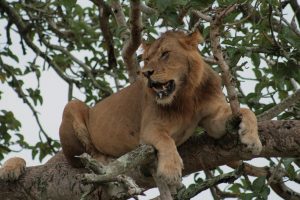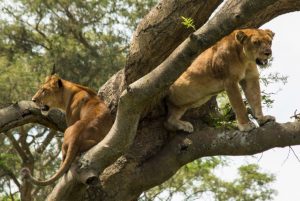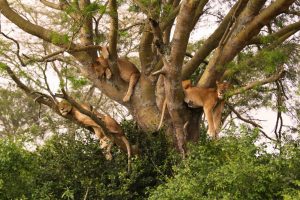Table of Contents
Top 5 Best Places To See Tree Climbing Lions
In this blog, we bring you the top 5 best places to see tree climbing lions. Tree climbing lions are a rare and fascinating phenomenon that occurs in a few scattered populations of lions in Africa. These lions have developed a unique behavior of climbing trees, something that is not commonly observed in other lion populations.


The most well-known population of tree-climbing lions is found in Queen Elizabeth National Park in Uganda and Lake Manyara National Park in Tanzania, where the lions are often seen lounging on branches high above the ground.
The reason for these lions’ development of this behavior is unknown, but it is thought to be a combination of factors, including the need to escape the heat and avoid biting insects, as well as to get a better view of their surroundings to locate prey. It is more common for lionesses and young lions to climb trees, while adult males are usually too heavy.
Tree climbing lions are typically larger and more muscular than other lions, which helps them to climb trees more easily. They’ve also evolved longer, more flexible claws for gripping onto branches as they climb.


Tree climbing lions can be found in several African countries, but the following are the best places to see them:
1. Queen Elizabeth National Park
Queen Elizabeth National Park is a protected area located in western Uganda. The park covers an area of 1,978 square kilometers and is home to a wide variety of wildlife, including elephants, lions, leopards, chimpanzees, hippos, crocodiles, and over 600 species of birds.
One of the unique attractions of the park is the tree climbing lions found in Ishasha sector of the park. These lions are known for their unusual behavior of climbing trees, which is believed to be due to the hot temperatures on the ground and the presence of biting insects. The best time to see these lions is during the dry season, which runs from June to September.
Other activities in Queen Elizabeth National Park include game drives, boat cruises on the Kazinga Channel, chimpanzee tracking in Kyambura Gorge, and cultural visits to the nearby communities. The park is also home to several lodges and campsites, providing accommodation options for visitors.
Overall, Queen Elizabeth National Park offers a unique wildlife experience in Uganda, and the tree-climbing lions are just one of the many reasons to visit this beautiful and diverse park.
2. Lake Manyara National Park
Lake Manyara National Park is a protected area located in northern Tanzania, near the town of Mto wa Mbu. The park covers an area of 330 square kilometers, and it’s named after the shallow alkaline lake that is its centerpiece. The park is known for its diverse ecosystem and abundant wildlife, including tree-climbing lions.
The park’s tree-climbing lions are a unique attraction and are among the few lion populations in the world that climb trees regularly. Visitors to the park are likely to see them resting on the acacia tree branches, especially during the hot afternoons.
Aside from the tree-climbing lions, Lake Manyara National Park is also home to large herds of elephants, buffalos, zebras, giraffes, and numerous bird species, including flamingos, pelicans, and storks. Visitors can explore the park on game drives, guided walks, or mountain bike rides, or take a canoe trip on the lake for a unique perspective of the wildlife and scenery.
Lake Manyara National Park is easily accessible from Arusha, and there are several lodges and campsites available for visitors. The dry season, from July to October, is the best time to visit the park because wildlife congregates around the lake and water sources.
3. Serengeti National Park In Tanzania
Serengeti National Park is one of the most famous and iconic protected areas in Africa, located in northern Tanzania. The park covers an area of 14,763 square kilometers, and it’s known for its vast savannahs, abundant wildlife, and the great migration of wildebeest and other herbivores.
The park is home to a large population of lions, and some of these lions have developed the unusual behavior of climbing trees, especially in the Ndutu area of the park. Visitors to the park can witness this unique behavior while on game drives or guided walks, usually during the hot afternoons when the lions seek refuge from the sun.
Aside from the tree-climbing lions, the Serengeti is home to large herds of elephants, buffalos, giraffes, zebras, and a variety of antelopes. The park is also a prime location for spotting cheetahs, leopards, hyenas, and other predators. Game drives, hot air balloon safaris, guided walks, and cultural visits to nearby Maasai villages are all options for visitors to explore the park.
The best time to visit the Serengeti depends on the specific activity or wildlife you want to see, but generally, the dry season from June to October is the best time for game viewing, while the rainy season from November to May is the best time for bird watching and the wildebeest calving season in February.
4. Tarangire National Park
Tarangire National Park is a protected area located in northern Tanzania, known for its unique ecosystem and diverse wildlife. The park covers an area of 2,850 square kilometers and is named after the Tarangire River that runs through it, providing a vital water source for wildlife during the dry season.
While Tarangire is not particularly known for its tree-climbing lions, some of the lions in the park have been known to climb trees, especially in the southern part of the park. Visitors can witness this unique behavior during game drives, especially in the afternoon when the lions seek refuge from the heat.
Elephants, lions, leopards, cheetahs, giraffes, zebras, and numerous antelope species can be found in Tarangire National Park. The park is also known for its baobab trees, which provide a stunning backdrop to the wildlife viewing experience.
Aside from game drives, visitors to Tarangire National Park can also enjoy guided walks, bird watching, and cultural visits to nearby Maasai villages. The best time to visit the park is from June to October, when wildlife congregates around the Tarangire River and other water sources.
5. Lake Nakuru National Park
Lake Nakuru National Park is a protected area located in central Kenya, known for its abundant birdlife and the large flocks of pink flamingos that cover the shores of Lake Nakuru. The park covers an area of 188 square kilometers, with the lake occupying a significant portion of the park.
While Lake Nakuru National Park is not particularly known for its tree-climbing lions, there have been rare sightings of lions climbing trees in the park. However, visitors to the park can still enjoy a diverse range of wildlife, including buffalos, zebras, giraffes, baboons, and numerous antelope species. The park is also home to several endangered species, such as the Rothschild’s giraffe and the black and white rhinos.
Aside from wildlife, the park has other attractions such as the Makalia Waterfall, the Baboon Cliff, and beautiful views of Lake Nakuru. Visitors can explore the park on game drives, guided walks, or bird watching tours, with the best time to visit being during the dry season from July to October.
Lake Nakuru National Park is easily accessible from Nairobi, with several lodges and campsites available for visitors. Overall, the park provides a one-of-a-kind and beautiful wildlife experience, with the added benefit of stunning views of the lake and flamingos.
Overall, tree climbing lions are a fascinating and unique aspect of African wildlife, and they provide an interesting example of how animals can adapt to their environment in unexpected ways.
It’s important to note that while tree climbing lions are a unique and fascinating sight to see, they are still wild animals and should be approached with caution. It’s always best to observe them from a safe distance and with the guidance of experienced guides or park rangers.
These are some of the best places to see lions in the world
